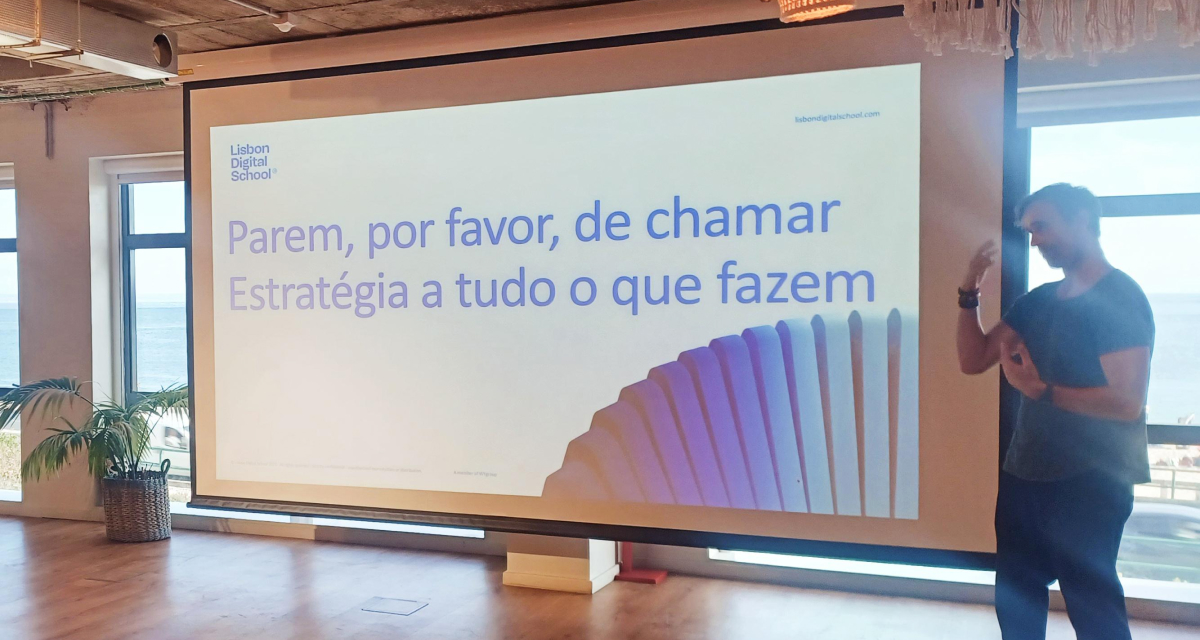In the most recent WYtalk, Paulo Rossas, CIO at Lisbon Digital School, brought up a topic focused on the proliferation and (trickery) use of the word “strategy” in the world of Digital Marketing, and how it simply… doesn’t make any sense.
Paulo told us that, in 1973, Adriano Celentano, an Italian artist, and singer, influenced by rock and roll and everything that was American, decided to “write” a song that sounded like English, but no one knew what he was saying. The background melody was good, but it didn’t mean anything: it was just random words he made up, which sounded like something English. The song is called “Prisencolinensinainciusol”. It reached number #1 on the country’s music chart, catapulting Adriano Celentano into the spotlight and becoming a national star. The hit became so famous that whenever people forget it, it comes back, without anyone realizing why, and it goes viral. There was even a new version, created in 2017 by Chicago’s Tub Ring and featured prominently in an episode of the Netflix series Fargo, more recently.
And why this story? According to Paulo, Digital Marketing is becoming a “Prisencolinensinainciusol” where everyone dances to an interesting melody, funk, pop, rock and roll, whatever. The melody is good, however, the vast majority is Adriano Celentano, words, expressions, structures, and moments are invented. Nobody knows what it means, but everyone sings, dances, thinks it’s funny and it even becomes a big hit. In all the lyrics of the song “Prisencolinensinainciusol”, there is only one true word: “alright”.
When we look at the current music of Digital Marketing, there is one word that is repeated in everyone’s speech, which is the word “Strategy”. The problem is that no one knows where to apply it, a bit like “alright”. This applies to everything, everything is “alright”. “Strategy” became everything. Everything is strategy. But is this okay? No. “Not alright.” The “rock and roll” of Digital Marketing is fantastic, it has great potential, we cannot just cling to a “Prisencolinensinainciusol” and pretend that we know what we are saying. To be a Strategy, a Strategy must have Objectives and much more.
«But after all, what is Strategy? In essence, Strategy is Chaos. If, amid Chaos, we understand the patterns and can prove them, we will win. Strategy is recognizing patterns. We can all be strategists, as long as we can recognize patterns. If we understand what will or can happen, we will win. Where does real value appear, what makes us different from everyone else? When we dare to create our own standards and be able to prove them without anyone else being able to do it, and all of this, using data, evidence, human insights, innovation, and discomfort. It means following the Strategy rules and proving everything that was said», explained the CIO of Lisbon Digital School.
What are the objectives and what value do we want to extract from the strategy? It is necessary, according to Paulo, to understand the context of what is being done, what the world is doing, what the current trends are – will it be sustainable generations, inflation, or something else? And of course, who are you talking to, and where is the target – it is important to find out more about the target, their interests, age, gender, and where we can find them – whether on Google, email, social media … and what social networks can we find them! Then, we have to understand what can be done for this target: «Why do they need me? What do I solve? What is the stimulus and the path to solving this problem?»
Once we have identified the path to take, we can choose where to focus the content, depending on what you want. «If we want to be more aspirational, we should opt for Instagram, if the focus is on entertainment or education, for example, we can use Tiktok, etc», he adds.
The last step, and one of the most relevant of all, is the choice and analysis of KPIs. «What are we going to evaluate, and measure, to be considered a success? If the objective is to have more people on the Website, the metric is traffic. But among all the options, we have to choose the most appropriate one: will it be all traffic, or just quality traffic? Is the focus on organic or paid? And if we want to measure, for example, entries/visitors on the website, the bounce rate, the time on the website… always start with the question: what is a positive number for us in the end? After all this, knowing what we really want to measure, achieve, and prove, it is indeed possible for there to be a Strategy. “Alright?”, he concludes.
Article originally published in LÍDER Magazine.
